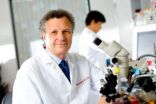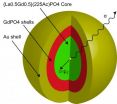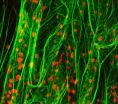(Press-News.org) LA JOLLA, Calif., February 4, 2013 – Nitric oxide, a gaseous molecule produced in the brain, can damage neurons. When the brain produces too much nitric oxide, it contributes to the severity and progression of stroke and neurodegenerative diseases such as Alzheimer's. Researchers at Sanford-Burnham Medical Research Institute recently discovered that nitric oxide not only damages neurons, it also shuts down the brain's repair mechanisms. Their study was published by the Proceedings of the National Academy of Sciences the week of February 4.
"In this study, we've uncovered new clues as to how natural chemical reactions in the brain can contribute to brain damage—loss of memory and cognitive function—in a number of diseases," said Stuart A. Lipton, M.D., Ph.D., director of Sanford-Burnham's Del E. Webb Neuroscience, Aging, and Stem Cell Research Center and a clinical neurologist.
Lipton led the study, along with Sanford-Burnham's Tomohiro Nakamura, Ph.D., who added that these new molecular clues are important because "we might be able to develop a new strategy for treating stroke and other disorders if we can find a way to reverse nitric oxide's effect on a particular enzyme in nerve cells."
Nitric oxide inhibits the neuroprotective ERK1/2 signaling pathway
Learning and memory are in part controlled by NMDA-type glutamate receptors in the brain. These receptors are linked to pores in the nerve cell membrane that regulate the flow of calcium and sodium in and out of the nerve cells. When these NMDA receptors get over-activated, they trigger the production of nitric oxide. In turn, nitric oxide attaches to other proteins via a reaction called S-nitrosylation, which was first discovered by Lipton and colleagues. When those S-nitrosylated proteins are involved in cell survival and lifespan, nitric oxide can cause brain cells to die prematurely—a hallmark of neurodegenerative disease.
In their latest study, Lipton, Nakamura and colleagues used cultured neurons as well as a living mouse model of stroke to explore nitric oxide's relationship with proteins that help repair neuronal damage. They found that nitric oxide reacts with the enzyme SHP-2 to inhibit a protective cascade of molecular events known as the ERK1/2 signaling pathway. Thus, nitric oxide not only damages neurons, it also blocks the brain's ability to self-repair.
INFORMATION:
This research was funded by the U.S. National Institutes of Health grants R01EY05477, P01HD29687, P01ES016738 and P30NS076411.
The study was co-authored by Zhong-Qing Shi, Sanford-Burnham; Carmen R. Sunico, Sanford-Burnham; Scott R. McKercher, Sanford-Burnham; Jiankun Cui, Sanford-Burnham; Gen-Sheng Feng, University of California, San Diego; Tomohiro Nakamura, Sanford-Burnham; and Stuart A. Lipton, Sanford-Burnham.
About Sanford-Burnham Medical Research Institute
Sanford-Burnham Medical Research Institute is dedicated to discovering the fundamental molecular causes of disease and devising the innovative therapies of tomorrow. The Institute consistently ranks among the top five organizations worldwide for its scientific impact in the fields of biology and biochemistry (defined by citations per publication) and currently ranks third in the nation in NIH funding among all laboratory-based research institutes. Sanford-Burnham utilizes a unique, collaborative approach to medical research and has established major research programs in cancer, neurodegeneration, diabetes, and infectious, inflammatory, and childhood diseases. The Institute is especially known for its world-class capabilities in stem cell research and drug discovery technologies. Sanford-Burnham is a U.S.-based, non-profit public benefit corporation, with operations in San Diego (La Jolla), California and Orlando (Lake Nona), Florida. For more information, news, and events, please visit us at sanfordburnham.org.
Chemical reaction keeps stroke-damaged brain from repairing itself
In stroke and other neurological disorders, nitric oxide damages neurons and blocks the brain's ability to repair itself
2013-02-05
ELSE PRESS RELEASES FROM THIS DATE:
Biodiversity exploration in the 3-D era
2013-02-05
Taxonomy – the discipline that defines and names groups of organisms – is a field of science that still employs many of the methods used during the beginnings of the discipline in the 18th century. Despite the increasing use of molecular information to delineate new species, the study of the morphology of specimens remains one of the major tasks of taxonomists. These studies often require first-hand examination of the reference specimens (so-called type material) deposited at museum collections around the globe - a time-consuming and laborious task.
To facilitate this ...
New study finds water tubing-related injuries up 250 percent
2013-02-05
Water tubing, a recreational activity in which participants ride an inner tube which is pulled behind a boat by a tow rope, has grown in popularity in recent years. Unfortunately, the number of injuries related to this activity has also increased.
According to a new study by researchers at the Center for Injury Research and Policy of The Research Institute at Nationwide Children's Hospital, the annual number of water tubing-related injuries increased 250 percent over the 19-year study period, rising from 2,068 injuries in 1991 to 7,216 injuries in 2009. Given that more ...
Finding the way to memory
2013-02-05
Our ability to learn and form new memories is fully dependent on the brain's ability to be plastic – that is to change and adapt according to new experiences and environments. A new study from the Montreal Neurological Institute – The Neuro, McGill University, reveals that DCC, the receptor for a crucial protein in the nervous system known as netrin, plays a key role in regulating the plasticity of nerve cell connections in the brain. The absence of DCC leads to the type of memory loss experienced by Dr. Brenda Milner's famous subject HM. Although HM's memory loss resulted ...
February 2013 story tips from Oak Ridge National Laboratory
2013-02-05
HEALTH – Neutron imaging breast cancer . . .
More precise optical imaging is vital for better diagnosis of breast cancer, which strikes one in eight women annually in the United States alone. Researchers at Oak Ridge National Laboratory and the University of Tennessee are using the neutron imaging beam line at ORNL's High Flux Isotope Reactor to evaluate neutron imaging as a powerful new tool for early detection. The study, led by Dr. Maria Cekanova of UT, working with imaging instrument scientist Hassina Bilheux, is using tissue from dogs treated at the UT College of ...
MU scientists build harness for powerful radiation cancer therapy
2013-02-05
VIDEO:
A new discovery might lead to alpha particle therapy for different types of cancer in the near future.
Click here for more information.
COLUMBIA, Mo. ¬— We've all heard that "it's not wise to use a cannon to kill a mosquito." But what if you could focus the cannon's power to concentrate power into a tiny space? In a new study, University of Missouri researchers have demonstrated the ability to harness powerful radioactive particles and direct them toward small cancer ...
Gene variants found to affect human lifespan
2013-02-05
By broadly comparing the DNA of children to that of elderly people, gene researchers have identified gene variants that influence lifespan, either by raising disease risk or by providing protection from disease.
"This research is the first genome-wide, population-based study of copy number variations in children associated with human longevity," said study leader Hakon Hakonarson, M.D., Ph.D., director of the Center for Applied Genomics at The Children's Hospital of Philadelphia.
The study appeared Jan. 30 in the open-access journal PLOS ONE.
Copy number variations ...
1990s drop in NYC crime not due to CompStat, misdemeanor arrests, study finds
2013-02-05
New York City experienced a historic decline in crime rates during the 1990s, but it was not due to the implementation of CompStat or enhanced enforcement of misdemeanor offenses, according to an analysis by New York University sociologist David Greenberg. The study, which appears in the journal Justice Quarterly, did not find a link between arrests on misdemeanor charges and drops in felonies, such as homicides, robberies, and assaults. In addition, the analysis revealed no significant drop in violent or property crime attributable to the NYPD's introduction of CompStat ...
How plants sense gravity -- a new look at the roles of genetics and the cytoskeleton
2013-02-05
Gravity affects the ecology and evolution of every living organism. In plants, the general response to gravity is well known: their roots respond positively, growing down, into the soil, and their stems respond negatively, growing upward, to reach the sunlight. But how do plants sense gravity and how do they direct or signal their cells to grow in response to it? Although botanists understand a great deal about how this works, a recent article in the recent issue of the American Journal of Botany reviews what we know so far, from mechanical to genetic approaches; it reveals ...
Some cancer mutations slow tumor growth
2013-02-05
CAMBRIDGE, MA -- A typical cancer cell has thousands of mutations scattered throughout its genome and hundreds of mutated genes. However, only a handful of those genes, known as drivers, are responsible for cancerous traits such as uncontrolled growth. Cancer biologists have largely ignored the other mutations, believing they had little or no impact on cancer progression.
But a new study from MIT, Harvard University, the Broad Institute and Brigham and Women's Hospital reveals, for the first time, that these so-called passenger mutations are not just along for the ride. ...
Early breast cancer diagnosis, survival rates low in rural India
2013-02-05
ANN ARBOR—Women in developed countries survive roughly 10 years longer after a breast cancer diagnosis compared to women in poor-to-middle-income countries, a new University of Michigan study suggests.
The report demonstrates the lack of access to good health care faced by women in poor countries, said the study's principal investigator Rajesh Balkrishnan, an associate professor at the U-M schools of Pharmacy and Public Health.
Early diagnosis and sustained treatment were the biggest hurdles and also the main indicators of patient survival, he said.
Balkrishnan and ...
LAST 30 PRESS RELEASES:
Interaction of climate change and human activity and its impact on plant diversity in Qinghai-Tibet plateau
From addressing uncertainty to national strategy: an interpretation of Professor Lim Siong Guan’s views
Clinical trials on AI language model use in digestive healthcare
Scientists improve robotic visual–inertial trajectory localization accuracy using cross-modal interaction and selection techniques
Correlation between cancer cachexia and immune-related adverse events in HCC
Human adipose tissue: a new source for functional organoids
Metro lines double as freight highways during off-peak hours, Beijing study shows
Biomedical functions and applications of nanomaterials in tumor diagnosis and treatment: perspectives from ophthalmic oncology
3D imaging unveils how passivation improves perovskite solar cell performance
Enriching framework Al sites in 8-membered rings of Cu-SSZ-39 zeolite to enhance low-temperature ammonia selective catalytic reduction performance
AI-powered RNA drug development: a new frontier in therapeutics
Decoupling the HOR enhancement on PtRu: Dynamically matching interfacial water to reaction coordinates
Sulfur isn’t poisonous when it synergistically acts with phosphine in olefins hydroformylation
URI researchers uncover molecular mechanisms behind speciation in corals
Chitin based carbon aerogel offers a cleaner way to store thermal energy
Tracing hidden sources of nitrate pollution in rapidly changing rural urban landscapes
Viruses on plastic pollution may quietly accelerate the spread of antibiotic resistance
Three UH Rainbow Babies & Children’s faculty elected to prestigious American Pediatric Society
Tunnel resilience models unveiled to aid post-earthquake recovery
Satellite communication systems: the future of 5G/6G connectivity
Space computing power networks: a new frontier for satellite technologies
Experiments advance potential of protein that makes hydrogen sulfide as a therapeutic target for Alzheimer’s disease
Examining private equity’s role in fertility care
Current Molecular Pharmacology achieves a landmark: real-time CiteScore advances to 7.2
Skeletal muscle epigenetic clocks developed using postmortem tissue from an Asian population
Estimating unemployment rates with social media data
Climate policies can backfire by eroding “green” values, study finds
Too much screen time too soon? A*STAR study links infant screen exposure to brain changes and teen anxiety
Global psychiatry mourns Professor Dan Stein, visionary who transformed mental health science across Africa and beyond
KIST develops eco-friendly palladium recovery technology to safeguard resource security
[Press-News.org] Chemical reaction keeps stroke-damaged brain from repairing itselfIn stroke and other neurological disorders, nitric oxide damages neurons and blocks the brain's ability to repair itself



